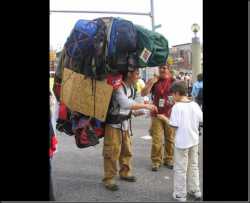>>2386056First thing is to take a look at what you are bringing, and what is redundant, unused, or inefficient. If it's not shelter, food, water, or weather related it's likely not necessary or can be adjusted for space and weight savings. The 2nd thing is to evaluate gear and determine if there is a lighter option that accomplishes the same thing.
Examples:
Redundancy - Eliminate multiple sets of the same clothing. For example on a recent 3 day summer hike I had one set of underwear, shorts and a sun shirt to hike in, one set of base layer for camp/insulation, and 2 pairs of socks. If I'm not wearing it or sleeping in it I'm not bringing it.
Unused - I sometimes bring a camp saw but on a hike where I'm cooking off a canister stove and then going to bed I'm not bringing it on a longer backpacking trip.
Inefficient - You could bring all of your water for a weekend but a pair of bottles and a filter is lighter. Look at the food you bring and figure out if can get a sufficient meal in more calorie dense form. Can you swap a lantern for a headlamp etc.
Lighter/Smaller Gear - My old 35F (survival rating) sleeping bag was close to 2lbs and 20L of space. My summer down quilt is 40F (comfort rating) 1lb and compacts to almost 6L volume.
A good start OP is to make a list of what specific gear (item, manufacturer ideally) you are bringing for a given trip and it's weight in a spreadsheet. I can try to advise on the gear list if you post it here. I'm not an ultralight thru hiker or gram counter but I can at least give you an opinion.

